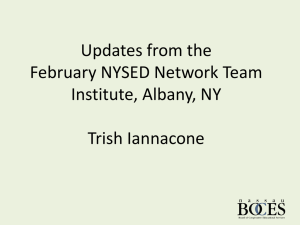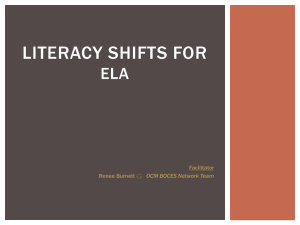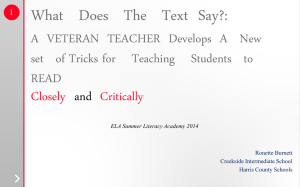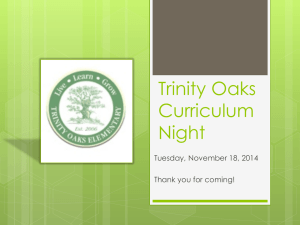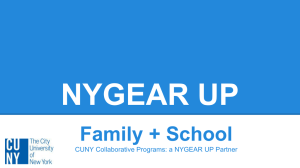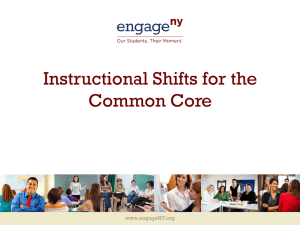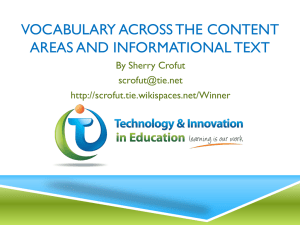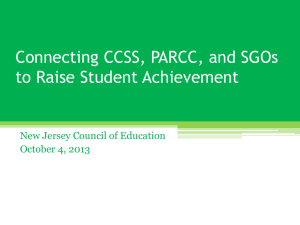Kansas College and Career Readiness Standards
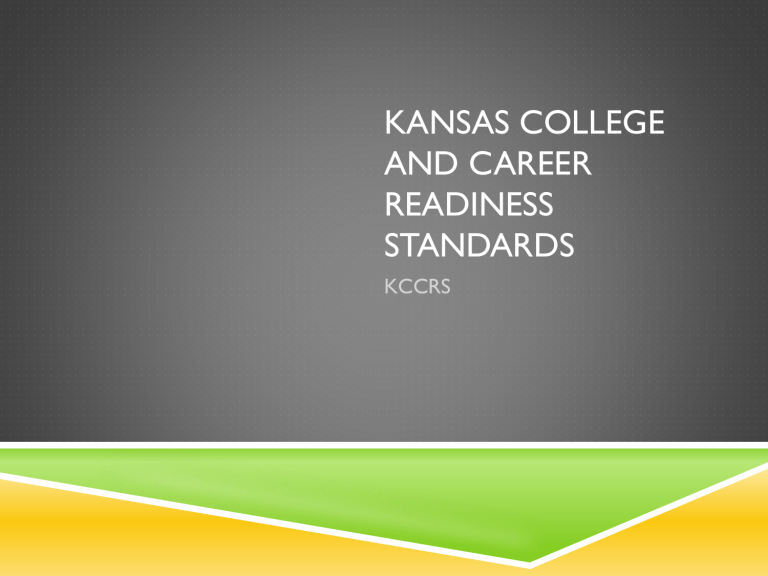
KANSAS COLLEGE
AND CAREER
READINESS
STANDARDS
KCCRS
It’s a new way of learning and processing information.
WHY ALL THE HPYE WITH
KCCRS?
NEED FOR CHANGE IN THE
EDUCATIONAL SYSTEM
Predominantly school are still designed as they were for the industrial period
Turning out mass workforce for high intensity labor
Fundamental switch from manual labor to “thinking” labor
Schools need to change to accommodate the new information and technology era.
HOW MUCH INFORMATION DO WE
HAVE?
The study has, for the first time, used "terabytes" as a common standard of measurement to compare the size of information in all media, linking and interpreting research reports from industry and academia. One terabyte equals a million megabytes or the text content of a million books.
The United States produces 35 percent of all print material, 40 percent of the images and more than half of the digitally stored material.
(University of California at Berkley study.)
HOW MUCH INFORMATION?
The directly accessible "surface" Web consists of about 2.5 billion documents and is growing at a rate of 7.3 million pages per day.
Counting the "surface" Web with the "deep" Web of connected databases, intranet sites and dynamic pages, there are about 550 billion documents, and 95 percent is publicly accessible.
A white-collar worker receives about 40 e-mail messages daily at the office.
(University of California at Berkley study.)
INFO
Print accounts for such a miniscule amount of the total information storage.
Vast amount of unique information stored and also created by individuals.
Original documents created by office workers represent nearly 90 percent of all original paper documents, while 56 percent of magnetic storage is in single-user desktop computers.
Ordinary people not only have access to huge amounts of data, but are also able to create gigabytes of data themselves
Predominance of digital information is because digital information is potentially accessible anywhere on the Internet and is a "universal" medium
(University of California at Berkley study.)
WHAT DOES THIS MEAN FOR THE
WORKFORCE?
Need for postsecondary education and training
Use of higher order thinking skills
Use of technology
Continual change
People who can think about thinking
Creative, analytical minds
A NEW GENERATION OF STANDARDS
FOR COLLEGE AND CAREER READINESS
These standards are our renewed opportunities to:
Advance instruction
– shift focus from AYP to CCR
Cultivate habits of mind
– approaches to learning that are intellectual, practical, and spur student success
Facilitate collaboration
– among students, among disciplines, among states
21 ST
CENTURY
LEARNER/TEACHER/PRINCIPAL
CONSIDERATIONS:
Habits of Mind
1.
2.
3.
4.
5.
6.
7.
8.
16 HABITS OF MIND
DRAWN FROM RESEARCH ON HUMAN EFFECTIVENESS,
DESCRIPTIONS OF REMARKABLE PERFORMERS, AND ANALYSES OF
THE CHARACTERISTICS OF EFFICACIOUS PEOPLE
Persisting
Managing Impulsivity
Listening with Understanding and
Empathy
Thinking Flexibly
Thinking About Thinking
(Metacognition)
Striving for Accuracy
Questioning and Posing Problems
Applying Past Knowledge to New
Situations
9.
10.
11.
12.
13.
14.
15.
16.
Thinking and Communicating with
Clarity and Precision
Gathering Data Through All Senses
Creating, Imagining, Innovating
Responding with Wonderment and
Awe
Taking Responsible Risks
Finding Humor
Thinking Interdependently
Remaining Open to Continuous
Learning from Costa, A.L. & B. Kallick. Learning and Leading with Habits of Mind: 16 Essential
Characteristics for Success. ASCD, 2008.
http://www.ascd.org/publications/books/108008/chapters/Describing-the-Habits-of-Mind.aspx
Pre-KCCRS to Post-KCCRS
MAKING THE SHIFT
COMMON CORE SHIFTS
ELA & CONTENT LITERACY
Balancing Informational & Literary Texts (Grades PK-5)
Knowledge in the Disciplines (Grades 6-12)
Staircase of Complexity
Text-based Answers
Writing from Sources
Academic Vocabulary
ELA Shift 1
BALANCING INFORMATIONAL
AND LITERARY TEXT
SHIFT 1
Use a variety of texts
Use informational texts, fictional and nonfictional texts
Include other types of texts like articles, internet, speeches.
ELA Shift 2
BUILDING KNOWLEDGE IN THE
DISCIPLINES
SHIFT 2
Reading across the disciplines
Use content areas to further reading
Reading can be taught in ALL content areas
Post-
CCSS
Core Texts K-5
Kindergarten First Grade
Paired
Texts:
The Human
Body
SHIFT 1
Balancing
Informational and
Literary Texts
SHIFT 2
(Link to 6-12)
Building
Knowledge in the
Disciplines
Second-Third Grade
Fourth-Sixth Grade
ELA Shift 3
INCREASE COMPLEXITY OF TEXT
AT EACH GRADE LEVEL
SHIFT 3
Read and reread
Be persistent; read challenging materials
Leveled readers for struggling readers
Scaffolding
Build in a joy of read by high interest texts at appropriate reading level for the student.
Use all parts of the text, glossary, table of contents, picture captions, etc
SHIFT 3
STAIRCASE OF COMPLEXITY
Increase in text complexity at each grade level
Qualitative
Levels of meaning
Structure
Clarity of language
Knowledge demands
Quantitative
Word length
Sentence length
Text cohesion
Reader &
Task
Motivation
Knowledge
Experience
Expectation of proficiency and independence in reading grade level text
Appendix B:
Text Exemplars and Sample
Performance
Tasks
PRE-CCSS
K-5
Thank you for hands and feet that keep a beat, for ears that hear, and eyes that see.
Thank you for each bendy knee.
SHIFT 3
Staircase of
Complexity
POST-CCSS
K-5
and vegetables and protein foods like meat, milk, and beans you are giving your body the things it needs to grow.
SHIFT 3
Staircase of
Complexity
ELA Shift 4
TEXT BASED ANSWERS
SHIFT 4
Questions tied directly to the text, but extend beyond the literal
Students must cite text to support answers
Personal opinions, experiences, and connections to the text are minimized in favor of what the text actually says or doesn’t say
Answers to questions are found in the text and student gives evidence from text to support their answers.
Pre-CCSS
What are three ways that food helps your body?
2 nd – 3 rd Grade
We have learned that food keeps you alive, healthy, and strong . Find three reasons from the text which support how this happens.
Post-CCSS
SHIFT 4
Text-based
Answers
ELA Shift 5
WRITING FROM SOURCES
SHIFT 5
Fewer personal narratives
Argumentative takes center stage as preferred writing genre
Use multiple sources
Analyze and synthesize information
Develop own voice for writing
SHIFT 5
WRITING FROM SOURCES
Three
Text
Types
Argument Supporting a claim with sound reasoning and relevant evidence
Informational/Ex planatory
Writing
Narrative
Writing
Increase subject knowledge
Explain a process
Enhance comprehension
Conveys experience i.e. fictional stories, memoirs, anecdotes, autobiographies
Argumentative writing is especially prominent in the CCSS
Appendix C:
Samples of
Student Writing
Pre-CCSS
Why is it important to maintain a healthy diet?
4th – 5th Grade
Examine and describe the relationship between proper nutrition and a healthy lifestyle. Use facts, concrete details, quotations, and other evidence from the text to explain how this information contributes to an understanding of overall health.
Post-CCSS
SHIFT 5
Writing from
Sources
ELA Shift 6
ACADEMIC VOCABULARY
SHIFT 6
ACADEMIC VOCABULARY
Tier One
Words
• Words of everyday speech
Tier Two
Words
• Not specific to any one academic area
• Generally not well-defined by context or explicitly defined within a text
• Wide applicability to many types of reading
Tier
Three
Words
• Domain specific
• Low-frequency
• Often explicitly defined
• Heavily scaffolded
Ramp up instruction of Tier Two words
Pre-CCSS vitamins stomach digestion calories
K-5
SHIFT 6
Academic
Vocabulary
Post-CCSS
Tier 3
Words vitamins stomach digestion calories
K-5
Tier 2
Words energy
SHIFT 6
Academic
Vocabulary detect supply manufacture
MATH
AREAS FOR EMPHASIS FOR MATHEMATICS
Focus strongly where the Standards focus, using the Critical Areas
Coherence: Think across grades, and link to major topics within grades
Rigor: In major topics, pursue conceptual
understanding, application, and procedural skill and fluency
Mathematical Practices and 6 Shifts - Considerations
MATHEMATICAL PRACTICES
(PAGES 6-7 OF THE
DOCUMENT)
1. MAKE SENSE OF PROBLEMS AND PERSEVERE IN
SOLVING THEM.
2. REASON ABSTRACTLY AND QUANTITATIVELY.
3. CONSTRUCT VIABLE ARGUMENTS AND CRITIQUE
THE REASONING OF OTHERS.
4. MODEL WITH MATHEMATICS.
5. USE APPROPRIATE TOOLS STRATEGICALLY.
6. ATTEND TO PRECISION.
7. LOOK FOR AND MAKE USE OF STRUCTURE.
8. LOOK FOR AND EXPRESS REGULARITY IN REPEATED
REASONING.
Mathematics Shift 1
FOCUS
PRIORITIES IN MATH
6
7
8
Grade
K–2
3–5
Priorities in Support of Rich Instruction and Expectations of
Fluency and Conceptual Understanding
Addition and subtraction, measurement using whole number quantities
Multiplication and division of whole numbers and fractions
Ratios and proportional reasoning; early expressions and equations
Ratios and proportional reasoning; arithmetic of rational numbers
Linear algebra
39
Mathematics Shift 2:
COHERENCE
SHIFT 2 COHERENCE
Build from year to year
Scope and sequence
Vertical Alignment of curriculum is crucial
Mathematics Shift 3:
FLUENCY
KEY FLUENCIES
Grade
K
1
2
3
4
5
6
7
8
Required Fluency
Add/subtract within 5
Add/subtract within 10
Add/subtract within 20
Add/subtract within 100 (pencil and paper)
Multiply/divide within 100
Add/subtract within 1000
Add/subtract within 1,000,000
Multi-digit multiplication
Multi-digit division
Multi-digit decimal operations
Solve px + q = r, p(x + q) = r
Solve simple 2 2 systems by inspection
43
Mathematics Shift 4:
DEEP UNDERSTANDING
SHIFT 4 DEEP UNDERSTANDING
The assumption here is that students who have deep conceptual understanding can:
1.
2.
Find “answers” through a number of different routes (More than one way to solve a problem.)
Articulate their mathematical reasoning (Explain how they got the answer.)
3.
4.
Be fluent in the necessary baseline functions in math, so that they are able to spend their thinking and processing time unpacking mathematical facts and make meaning out of them. (Has automaticity of computation skills.)
Rely on their teachers’ deep conceptual understanding and intimacy with the math concepts (Teachers have clear understanding of math.)
Mathematics Shift 5:
APPLICATION
SHIFT 5 APPLICATION
•
•
•
•
Apply math in other content areas and situations, as relevant
Choose the right math concept to solve a problem when not necessarily prompted to do so
Apply math including areas where its not directly required (i.e. in science)
Provide students with real world experiences and opportunities to apply what they have learned
Mathematics Shift 6:
DUAL INTENSITY
SHIFT 6 DUAL INTENSITY
Practice for fluency
Practice for understanding and application
Apply both.
Must be able to do both computation and concepts well. (Focus is no longer one or the other depending on grade level.)
DLM-KAA
Qualifying Criteria
To qualify for the Dynamic
Learning Maps and KAA assessment, students must qualify for both sections below.
SECTION 1
You must answer Yes to all three questions to qualify.
1. The student has a significant cognitive disability
2. The student is learning content standards linked to
(derived from) the Kansas College and Career Ready Standards
3. The student requires extensive direct instruction and substantial modifications and supports to achieve measureable gains in the grade- and age-appropriate curriculum.
SECTION 2 ALL ANSWERS MUST BE NO
TO QUALIFY
1.
2.
5.
6.
Question- Did you make the decision based on:
3.
4.
7.
A disability category or label
Poor attendance or extended absences
Native language/social/cultural or economic difference
Expected poor performance on the general education assessment
Services student receives
Educational environment or instructional setting
Percent of time receiving special education
8. English Language Learner (ELL) status
9. Low reading level/ achievement level
10. Anticipated student’s disruptive behavior
11. Impact of student scores on accountability system
12. Administrator decision
13. Anticipated student’s emotional duress
DLM eligibility
1% OF TESTED POPULATION
CHOOSING INDICATORS
Indicators are chosen from the appropriate grade level of the DLM-EE
(Dynamic Learning Maps—Essential Elements)
We are still telling everyone to put the indicators on their checklists
Write a separate goal and checklist for each content area.
Students who have taken the Kamm in the past will now take the General
Education with Accommodations
NO KAMM!
GENERAL ED. TEST WITH
ACCOMMODATIONS
Accomodations must be listed on the IEP
Must be specific
Shortened assignment; shortened by 50%
Extended time—Time plus ½
Frequent breaks—Movement, stretch, break every 15 minutes
Read aloud—At least 50% of all assignments read aloud. All tests read aloud. (KCA recording)
Must be provided also in General Ed. Classroom
Testing coordinator will report accomodations to state when ordering tests.
Thank you!

